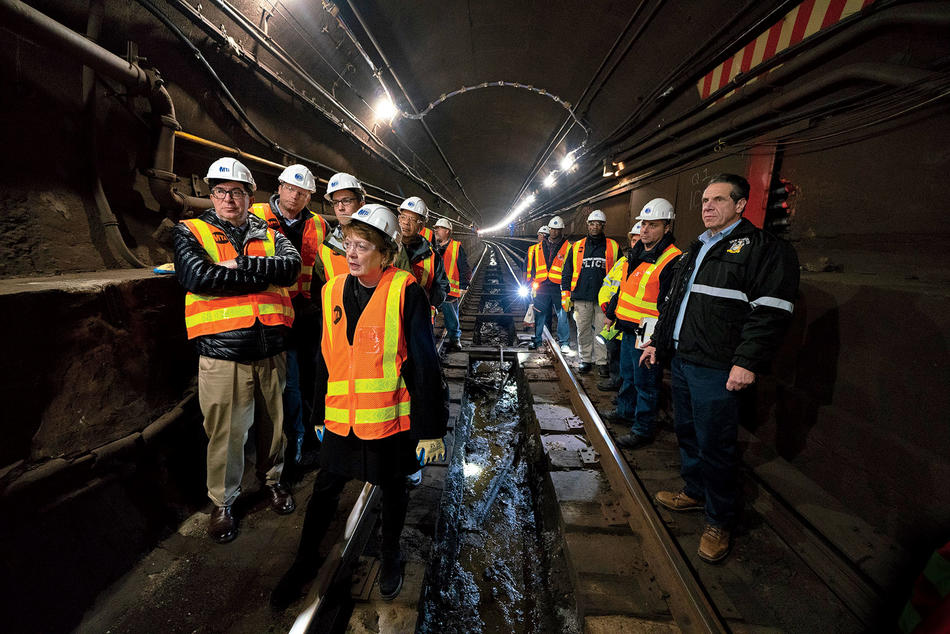It was going to be one of the worst-ever disruptions to New York City’s subway system: for fifteen months beginning in April, the L train, which carries a quarter of a million riders between Brooklyn and Manhattan every day, would shut down completely. Transit officials said the closure was necessary to make major repairs to the 14th Street tunnel, which carries the L train beneath the East River. Brooklynites for whom the train is a commuter lifeline called it the “L-pocalypse.”
And then, in early December, New York governor Andrew Cuomo got in touch with the deans of Columbia’s and Cornell’s engineering schools and invited them to review the renovation plans drawn up by the state’s Metropolitan Transportation Authority (MTA), with an eye toward finding a more expedient solution.
“He said that he wanted someone from the outside to come in and take a fresh look to make sure that the MTA’s plan was absolutely the best one possible, or to see if there was another, better way to rehabilitate the tunnel,” says Mary Boyce, dean of Columbia Engineering. “In particular, he was interested to know if the tunnel’s shutdown could be shortened or perhaps avoided altogether — although he didn’t seem particularly hopeful about the latter being achievable.”
For the next three weeks, Boyce, together with Cornell engineering dean Lance Collins and a number of their schools’ top faculty members, spent hundreds of hours scrutinizing the MTA’s plans. They pored over stacks of tunnel blueprints, demolition and construction proposals, and safety and environmental-impact assessments. They interviewed dozens of transit officials and private contractors working on the project; they climbed down into the 14th Street tunnel to inspect the damage firsthand; and they studied the designs of newer subway systems in London, Riyadh, Singapore, and Hong Kong.
By the end of December, the professors had come up with a new strategy for fixing the tunnel, which had been damaged by flooding during Hurricane Sandy in 2012. And their solution would drastically reduce the amount of work required, allowing the L train to continue operating normally on weekdays, with only minor adjustments to its nighttime and weekend schedules. Their key insight was that a series of narrow concrete platforms that run alongside the tracks in the tunnel, which function both as emergency walkways and as protective encasements for power and communication cables, did not, as the MTA had assumed, need to be entirely demolished and rebuilt. Rather, the professors determined that ultrasound equipment could distinguish between those platform sections that had been irreparably damaged by the floodwaters and needed rebuilding and those that were still structurally sound or could be made so by reinforcing them with ultra-strong fiberglass. Furthermore, they said that the MTA didn’t need to remove old electrical cables from the platforms and weave new ones back in, as it had planned to do. Instead, the old cables could simply be abandoned and new ones hung on the tunnel’s walls.
As an insurance policy against future degradation, the Columbia and Cornell professors also proposed installing fiber-optic sensors on the concrete platforms to detect any structural problems that might arise; mounting lidar, or light-detection, sensors on L train cars to spot any obstructions ahead; and installing submarine-style doors at both ends of the tunnel to prevent flooding.
On January 3, the academic team, which included Columbia civil-engineering chair George Deodatis ’87SEAS, electrical-engineering chair Peter Kinget, and civil-engineering professor Andrew Smyth, joined Cuomo and other state officials at a press conference where the governor announced that the MTA had accepted the professors’ recommendations.
“No L-pocalypse,” attested MTA chairman Fernando Ferrer. “Instead, we’ll conduct all repairs on nights and weekends and will only need to close one tube at a time for repairs, allowing the second tube to run trains in both directions.”
Cuomo praised the academics’ strategy, predicting that it might one day be used to shore up other subway tunnels, in New York City and beyond. “This is really a unique design,” he said. “It could be a national model, because it is a totally different way to reconstruct a tunnel. It’s faster, it’s cheaper, it’s better.”
Boyce later said that her team’s eleventh-hour intervention to avert what could have been a major transportation nightmare for the city exemplified what engineering is all about: the coming together of people with diverse technical expertise to generate novel solutions to problems.
“I think one of the reasons we were able to find a better approach is that some of us hadn’t actually worked on subway tunnels before,” she said. “So we didn’t have any preconceived notions about what would or wouldn’t work. We utilized proven technologies from lots of different contexts and combined them in new and effective ways. In the end, we hope that we’ve helped position New York City as a leader in infrastructure maintenance, restoration, and overall innovation.”



